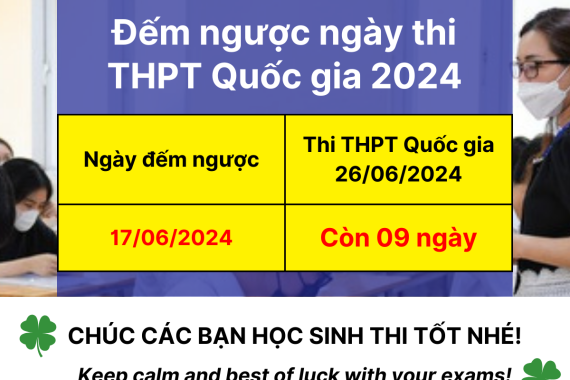TRUNG TÂM NGOẠI NGỮ QUỐC TẾ ĐẠI DƯƠNG
Xin chào các em!
Hôm nay chuyên viên giáo dục của công ty du học Đại Dương xin gửi đến các em một vài tips hữu ích cho dạng bài viết biểu đồ đường đơn giản (Line graph) trong IELTS Writing Task 1.
Linegraph được xem là một trong những phần khó với các em lần đầu học writing IELTS. Tuy nhiên, sau khi đọc kỹ các phần hướng dẫn dưới đây và các lời khuyên hữu ích của chuyên viên giáo dục, các em sẽ thấy mình có thể thực hiện loại bài viết này rất dễ dàng!
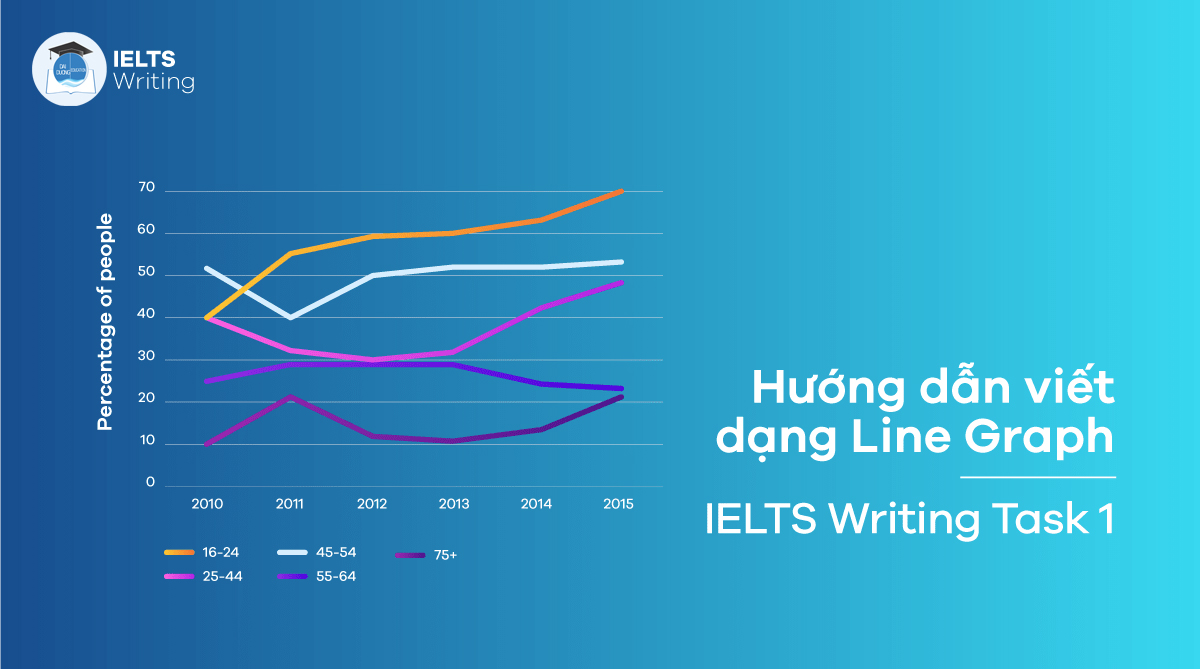
DẠNG LINE GRAPH LÀ GÌ?
Dạng Line Chart trong phần thi Writing Task 1 là dạng biểu đồ trong đó có chứa một số đường. Những đường này sẽ biểu diễn cho một sự thay đổi của một yếu tố nào đó qua nhiều mốc trong một khoảng thời gian (tuần, tháng, năm, thập kỷ,…). Nhiệm vụ của thí sinh là viết một đoạn văn ít nhất 150 từ miêu tả thông tin hiển thị trong biểu đồ nhưng không nêu quan điểm của mình trong bài viết.
Để hoàn thành bài viết linegraph, chúng ta có 4 bước.
Bước 1: Phân tích đề bài
Bước 2: Viết introduction
Bước 3: Xác định ý và viết overview
Bước 4: Lựa chọn, nhóm thông tin và viết 2 đoạn detail.
Tiếp theo chuyên viên giáo dục công ty Du Học Đại Dương sẽ hướng dẫn các em cách viết 4 bước nhé.
Cách viết line graph IELTS Writing task 1 dạng đơn giản (có ít hơn 3 đường)
Đề bài: The linegraph below shows consumers’ average annual expenditure on cell phone, national and international fixed-line and services in America between 2001 and 2010.
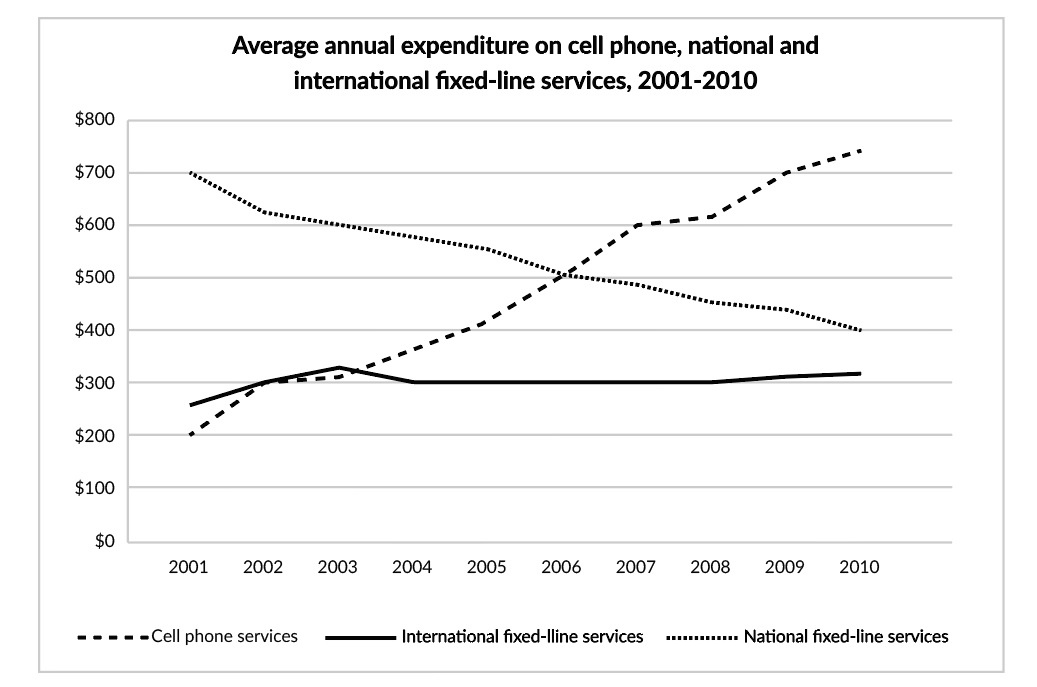
Bước 1: Phân tích đề line graph IELTS Writing task 1 dạng có ít hơn 3 đường
- Đối tượng (chủ ngữ) của biểu đồ là gì?
Đối tượng được đưa ra ở đây là sự chi tiêu hàng năm (lượng tiền). Chủ ngữ ở đây là “The amount of money spent on cell phone services/ national fixed-line services/ international fixed-line services” hoặc “Average yearly spending/expenditure on cell phone services/national fixed-line services/ international fixed-line services”.
- Đơn vị là gì?
Đơn vị được tính bằng $ – dollar.
- Có mốc hay khoảng thời gian không? Thì của động từ?
Khoảng thời gian trong 9 năm bắt đầu từ năm 2001 → dùng thì quá khứ đơn xuyên suốt cả bài.
Bước 2: Viết introduction bằng cách Paraphrase đề bài
Subject: The line graph =>The chart
Verb: shows => illustrates
Trả lời câu hỏi WHAT – WHERE – WHEN
Đề bài: The linegraph below shows US consumers’ average yearly expenditure on cell phone services, national and international fixed-line services in America between 2001 and 2010.
Paraphrase đề bài => The chart illustrates the average amount of money spent annually on mobile phone services, national and international landline services in the US over a nine-year period, from 2001 to 2010.
Bước 3: Xác định ý và viết Overview
Tìm 1-2 đặc điểm chung của biểu đồ line graph. Với dạng biểu đồ đường (có xu hướng), Overview đươc viết theo 2 ý sau:
1-Đặc điểm về xu hướng: nhìn từ đầu năm đến cuối năm xem xu hướng của các đường là gì? Là tăng? giảm? dao động liên tục? hay giữ nguyên?
2-Đặc điểm về độ lớn: Xác định đường có số liệu cao nhất, thấp nhất, hoặc thay đổi lớn nhất.
Áp dụng vào bài
Đặc điểm về xu hướng: Một đường có xu hướng tăng (cell phone services), một đường có xu hướng giảm (national fixed-line services), một đường gần như giữ nguyên trong cả giai đoạn (international fixed-line services).
Đặc điểm về độ lớn: Không có đường nào nằm cao nhất hoặc thấp nhất trong suốt quá trình, tuy nhiên có thể thấy đường international fix-lined services ở vị trí thấp nhất trong hầu hết các năm.
Từ 2 đặc điểm trên, đoạn overview có thể được viết dưới đây:
Overall, it is clear that while the yearly spending on mobile phones increased significantly, the opposite was true for national landline phone expenditure. Also, the figure for international fixed-line services was lowest during the period.
Lưu ý:
Cụm từ “It is clear that” là một cụm rất phổ biến để sử dụng mở đầu cho phần Overview cho tất cả các bài task 1 không chỉ riêng biểu đồ đường.
Cấu trúc “while S+V, S+V” dùng để so sánh giữa 2 xu hướng trái ngược nhau (ví dụ 1 tăng, 1 giảm) của 2 nhân tố được mô tả trong biểu đồ, giúp biến câu thành 1 câu phức.
Cụm từ “the opposite was true for something (điều ngược lại thì đúng cho…)” cũng là một cụm có thể áp dụng cho các bài task 1 khác, vừa ăn điểm từ vựng vừa tránh lặp lại chủ ngữ đã trình bày trước đó.
Cụm từ “during the period” được thay thế cho cụm “over a nine-year period, from 2001 to 2010” để tránh việc lặp từ.
Bước 4: Lựa chọn, nhóm thông tin và viết 2 đoạn Detail
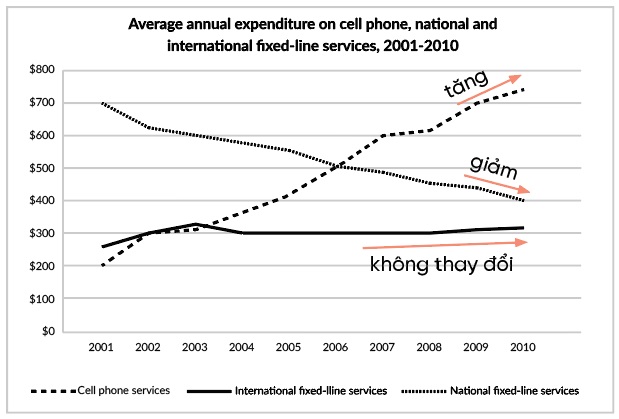
Với dạng line graph dưới 3 đường, cách nhóm thông tin hiệu quả đó là chia đôi quãng thời gian của biểu đồ rồi phân tích cho 2 đoạn details, cụ thể:
Detail 1: So sánh các đường ở điểm đầu, xu hướng cho đến điểm giữa (2001-2006)
+Năm 2001: số tiền lớn nhất là chi cho national fixed-line services khoảng $700, trong khi con số đó ở international fixed-line services chỉ là $250 và cell phone services chỉ $200 (lưu ý: bắt đầu Detail 1 thường là câu so sánh số liệu các đường ở năm đầu tiên).
+5 năm tiếp theo: chi tiêu trung bình hàng năm của national fixed-line services giảm đi khoảng $200, ngược lại chi tiêu cho cell phones tăng thêm khoảng $300. Chi tiêu cho International fixed-line services dao động trong khoảng dưới $300.
Lưu ý: Những năm 2002, 2003, 2004 không chứa số liệu nổi bật nên chỉ cần miêu tả xu hướng cho đến năm 2006.
Đoạn detail 1 hoàn thiện của bài line graph:
In 2001, there was an average of nearly $700 spent on national landline phone services by US residents, in comparison with only around $200 each on mobile phone and international landline services. Over the next five years, the average amount spent on national fixed-line phone services fell by approximately $200. By contrast, yearly spending on cell phone services witnessed a significant increase of roughly $300. At the same time, the figure for overseas landline services fluctuated slightly below $300.
Detail 2: Xu hướng từ điểm giữa đến điểm cuối, so sánh điểm cuối (năm 2006 – hết)
+2006: số liệu cho national fixed-line và cell phone services bằng nhau ở mức $500.
+Từ 2006-2010: cell phone services tiếp tục tăng và đạt gần $750, trong khi national fixed-line services giảm xuống còn khoảng $400. Chi tiêu cho international fixed-line services giữ nguyên trong giai đoạn này.
Lưu ý: Tương tự những năm 2007, 2008, 2009 không chứa số liệu nổi bật nên chỉ cần miêu tả xu hướng cho đến năm cuối cùng.
Đoạn detail 2 hoàn thiện của bài line graph:
In 2006, US consumers spent the same amount of money on mobile and national fixed-line services, with just over $500 on each. From the year 2006 onwards, it can be seen that the average yearly expenditure on mobile phone services surpassed that of national fixed-line phone services and became the most common means of telecommunication. To be more specific, yearly spending on mobile phone services increased to nearly $750 in the final year, whereas the figure for national landline phone services decreased to about $400 by the end of the period. During the similar period, there was stability in the figure for overseas phone services.
Bài mẫu 1 hoàn chỉnh
The chart illustrates the average amount of money spent annually on mobile phone services, national and international landline services in the US over a nine-year period, from 2001 to 2010.
Overall, it is clear that while the yearly spending on mobile phones increased significantly, the opposite was true for national landline phone expenditure. Also, the figure for international fixed-line services was lowest during the period.
In 2001, there was an average of nearly $700 spent on national landline phone services by US residents, in comparison with only around $200 each on mobile phone and international landline services. Over the next five years, the average amount spent on national fixed-line phone services fell by approximately $200. By contrast, yearly spending on cell phone services witnessed a significant increase of roughly $300. At the same time, the figure for overseas landline services fluctuated slightly below $300.
In 2006, US consumers spent the same amount of money on mobile and national fixed-line services, with just over $500 on each. From the year 2006 onwards, it can be seen that the average yearly expenditure on mobile phone services surpassed that of national fixed-line phone services and became the most common means of telecommunication. To be more specific, yearly spending on mobile phone services increased to nearly $750 in the final year, whereas the figure for national landline phone services decreased to about $400 by the end of the period. During the similar period, there was stability in the figure for overseas phone services.
Bài mẫu 2 dạng có 3 đường
The graph below shows the number of overseas visitors to three different areas in a European country between 1987 and 2007.
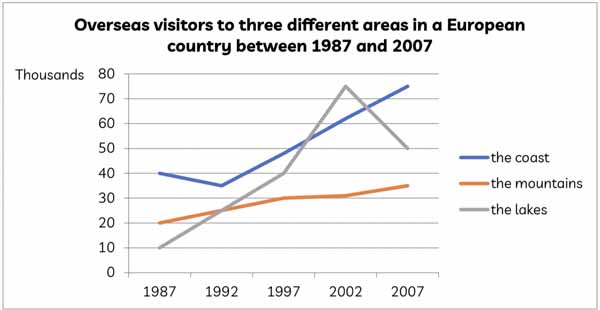 The given line graph depicts information about how many foreigners visited three separate regions in a European nation, during the span of a 20-year period from 1987 to 2007.
The given line graph depicts information about how many foreigners visited three separate regions in a European nation, during the span of a 20-year period from 1987 to 2007.
Overall, all regions attracted an increasing number of foreigners, and remarkably, the coast’ tourist figures took up the lion’s share among the three in the end of the period.
In more detail, at approximately 10,000 visitors coming to the lakes in 1987, this quantity gradually expanded to almost five-fold in the next 3 years before peaking at roughly75,000 tourists in 2002. Suddenly, it then plummeted by nearly one third in the end of the course.
With regards to tourist numbers in coastal and mountainous areas, the overall figures increased; however, mountainous areas remained the least attractive travel option out of the three. In 1987, the former’s number stood at 40,000 double that of the latter. In the next 14 years, the coast witnessed a brief fall by a few thousand in its figure, but subsequently it reached a significant climb of relatively 60,000 people, whereas the other figure inched its way to 30,000 in 2001. In the final 6 years, while the coast-visiting traveller number rose moderately to above 70,000, there was a negligible growth to half of the first figure in the mountain visitor number.
Trên đây là các hướng dẫn chi tiết và đơn giản nhất giúp cho các em viết được dạng linegraph dễ dàng. Nếu các em có bất cứ thắc mắc gì, hãy liên hệ ngay với Công ty du học Đại Dương để được tư vấn và giúp đỡ nhiệt tình. Công ty Du học Đại Dương tự hào là địa chỉ uy tín trong việc giảng dạy và cung cấp các khóa học IELTS đảm bảo đạt mục tiêu đầu ra, giúp sinh viên thuận lợi hơn trên con đường tiến đến giấc mơ du học.
Công ty Du học Đại Dương chúc các bạn thật nhiều may mắn, đạt điểm cao trong kỳ thi lấy bằng IELTS nhé!


